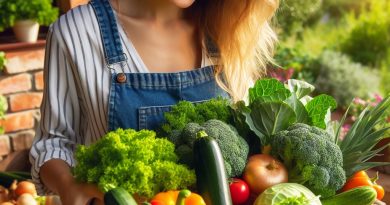Autumn’s Harvest: Guide to Seasonal Foods
Last Updated on March 2, 2024
Introduction
Autumn Harvest Seasonal Foods harness the vitality of the season, essential for our well-being.
These fresh, locally sourced ingredients not only elevate our culinary experiences but also provide a powerhouse of nutrients vital for our health.
As we embark on this gastronomic journey, it’s crucial to understand the profound impact of consuming foods in sync with nature’s rhythm.
Autumn’s Arrival
Bid farewell to the languid days of summer as autumn unfurls its majestic tapestry.
The air becomes crisper, the days shorter, and nature prepares for a serene slumber.
Amidst this transition, the autumn harvest takes center stage, presenting a cornucopia of flavors and textures unique to this time of year.
It’s a moment when the earth generously yields its final bounty before winter’s hibernation.
Our focus shifts to the vibrant hues and robust tastes that characterize autumn’s offerings.
From the earthy sweetness of pumpkins to the tartness of crisp apples, each harvest brings forth a symphony of ingredients that inspire warmth, comfort, and a connection to the changing seasons.
Join us as we delve into the diverse and delectable world of Autumn’s Harvest, exploring the culinary treasures this season has to offer.
Overview of Autumn’s Harvest
The different types of produce that are in season during Autumn
- Apples: Varieties like Honeycrisp, Granny Smith, and Golden Delicious are abundant during Autumn.
- Pumpkins: Perfect for pies and soups, pumpkins dominate the Fall season.
- Squash: Acorn, Butternut, and Spaghetti squash are some of the popular choices in Autumn.
- Sweet Potatoes: Versatile and nutritious, sweet potatoes flourish in Autumn.
- Pears: Different types of pears, such as Bartlett and Anjou, reach their peak during this season.
- Brussels Sprouts: These mini cabbage-like vegetables are widely available and packed with flavor.
- Cranberries: Known for their tartness, cranberries become ripe and ready for harvest in Autumn.
- Carrots: Carrots thrive in the cool weather of Autumn, making them sweeter and more delicious.
- Beets: Earthy and vibrant, beets are at their best during Autumn.
Importance of consuming seasonal foods
Consuming seasonal foods during Autumn provides numerous benefits for our health and the environment.
Firstly, seasonal produce is at its peak flavor and nutritional value.
Fruits and vegetables that ripen naturally in certain seasons are often tastier and richer in essential nutrients.
By consuming these foods, we can support our overall well-being.
Moreover, seasonal foods are harvested at the right time, ensuring they are at their freshest.
This freshness translates into better quality and longer shelf life.
Additionally, seasonal produce is usually grown locally, minimizing the need for long-distance transportation.
Buying local not only reduces carbon emissions but also supports the local economy and farmers.
Benefits of supporting local farmers during this time
- Fresher produce: By purchasing from local farmers, you can enjoy the freshest and most flavorful harvests.
- Community support: Supporting local farmers helps to strengthen the local economy and foster a sense of community.
- Environmental impact: Buying locally reduces carbon emissions associated with long-distance transportation.
- Preserving farmland: Supporting local farmers helps to maintain agricultural land and prevents urban sprawl.
- Food security: Encouraging local farming ensures a more steady and reliable food supply for the community.
- Connection with nature: Visiting local farms and purchasing directly from farmers can offer a deeper connection to the food we eat and the environment.
As Autumn arrives, it brings a bountiful harvest of delicious and nutritious produce.
Apples, pumpkins, squash, sweet potatoes, pears, and many more vegetables and fruits are at their prime during this season.
By consuming seasonal foods, we can enjoy the flavors and benefits that nature has to offer.
Furthermore, supporting local farmers not only ensures fresher and higher-quality produce but also contributes to the sustainability of our communities.
By choosing to buy from local farmers, we reduce our carbon footprint and strengthen our local economy.
So, let us embrace Autumn’s harvest and support our local farmers for a healthier and more sustainable future.
Read: Urban Farms: Revolution in Cities
Specific Autumn vegetables
Description and benefits of popular Autumn vegetables (e.g., pumpkins, squash, sweet potatoes)
- Pumpkins are versatile and packed with nutrients, providing vitamin A, fiber, and antioxidants.
- Squash varieties like butternut and acorn are rich in vitamins A, C, and E, and low in calories.
- Sweet potatoes are a nutritional powerhouse, offering vitamin A, vitamin C, and dietary fiber.
Recipe ideas incorporating these vegetables
- Creamy Pumpkin Soup: Roast pumpkin, blend with vegetable broth, add cream, and season to taste.
- Roasted Squash Salad: Toss cubed butternut squash with olive oil, salt, and pepper. Roast until tender and serve over mixed greens.
- Sweet Potato Casserole: Mash cooked sweet potatoes with butter, brown sugar, and cinnamon. Top with marshmallows and bake until golden.
Nutritional value and health benefits of Autumn vegetables
- Pumpkins: Apart from vitamin A, they also provide potassium, fiber, and beneficial antioxidants.
- Squash: Rich in phytochemicals and antioxidants, promoting a healthy immune system and reducing inflammation.
- Sweet potatoes: Packed with fiber and antioxidants, they support digestive health and boost the immune system.
Overall, Autumn vegetables offer a range of health benefits and delicious recipe possibilities.
Including these vegetables in our diet can enhance our nutrition and support our well-being during the fall season.
Read: Houston’s Farm-to-Table Hidden Gems
Showcasing Autumn fruits
Discussion of popular fruits during the season (e.g., apples, pears, cranberries)
Autumn is a time when nature gifts us with an abundance of delicious and nutritious fruits. Let’s explore some of the most popular ones:
- Apples: Crisp and juicy, apples are synonymous with the fall season. From sweet Honeycrisps to tart Granny Smiths, there’s an apple variety for every palate. They can be enjoyed on their own or used in a variety of recipes, both sweet and savory.
- Pears: Pears come in different varieties, such as Bartlett, Anjou, and Bosc, and they add a delightful sweetness to autumn dishes. They make a perfect addition to salads, cheese platters, and even desserts like poached pears. Pears are also rich in fiber and antioxidants, making them a healthy choice.
- Cranberries: These small, vibrant red berries are a staple during the autumn season. Known for their tartness, cranberries are often used in sauces, pies, and preserves. They are packed with vitamin C and are believed to have numerous health benefits, including improved digestion and enhanced immune system.
Recipes incorporating Autumn fruits
Now that we’ve talked about the popular autumn fruits, let’s delve into some mouth-watering recipes that showcase these seasonal delights:
- Apple Crumble: Peel and slice a few apples, toss them with cinnamon and sugar, and then top with a buttery crumble mixture. Bake until golden brown and enjoy the heavenly aroma wafting through your kitchen.
- Pear and Walnut Salad: Combine crisp lettuce, sliced pears, toasted walnuts, crumbled goat cheese, and a simple vinaigrette for a refreshing salad that’s bursting with autumn flavors.
- Cranberry Orange Bread: Perfect for breakfast or a snack, this moist and tangy bread is a delightful combination of fresh cranberries and citrusy goodness. Slice it up and spread some cream cheese for an extra treat.
Nutritional value and health benefits of Autumn fruits
In addition to their delicious taste, autumn fruits also offer a range of health benefits:
- Apples: They are high in fiber, which aids in digestion and promotes satiety. They are also rich in antioxidants that help protect against chronic diseases.
- Pears: Pears are a good source of dietary fiber and vitamin C. They are also rich in antioxidants that contribute to overall health and may help reduce the risk of certain cancers.
- Cranberries: These tart berries are packed with vitamins C, E, and K. They are also high in antioxidants and have antibacterial properties that support urinary tract health.
Including autumn fruits in your diet not only adds variety but also boosts your intake of essential nutrients.
So, take advantage of the season and savor the flavors and benefits of these beautiful fruits.
In fact, autumn brings a bountiful harvest of fruits that deserve to be celebrated.
From apples to pears and cranberries, these fruits can be enjoyed in various ways, from simple snacks to mouth-watering desserts.
Not only do they taste amazing, but they also offer a wide array of health benefits.
So, embrace the season, head to the local farmer’s market, and fill your baskets with the best autumn fruits nature has to offer!
Read: Philly Farm-to-Table Culinary Stars

Including Autumn herbs and spices
Autumn is a wonderful season full of colorful foliage, cozy sweaters, and of course, delicious foods.
One of the joys of this time of year is the abundance of fresh herbs and spices that are harvested.
These aromatic additions can enhance the flavors of autumn dishes, and also provide numerous health benefits.
In this section, we will explore the common herbs and spices used during autumn, their uses and benefits, as well as some recipe ideas to incorporate them into your meals.
Explanation of Common Herbs and Spices used during Autumn
- Cinnamon: This warm and sweet spice is a staple in autumn dishes, adding a rich flavor to desserts, drinks, and even savory recipes.
- Nutmeg: Known for its earthy and slightly nutty taste, nutmeg is often used in baking, soups, and stews during the autumn season.
- Ginger: With its distinct spiciness, ginger is perfect for warming autumn dishes like curries, stir-fries, and gingerbread.
- Sage: This fragrant herb is commonly used in roasted meats and stuffing, adding a savory and slightly minty flavor.
- Thyme: With its earthy and floral notes, thyme is a versatile herb that complements a wide range of autumn dishes, including roasted vegetables and soups.
Uses and Benefits of these Herbs and Spices
Cinnamon, apart from its delicious taste, has been found to have antioxidant and anti-inflammatory properties.
Nutmeg is known for its digestive benefits, and ginger is commonly used to relieve nausea and promote digestion.
Sage contains compounds that have antimicrobial properties and thyme is packed with vitamins and minerals that can support the immune system.
Recipe Ideas incorporating Autumn Herbs and Spices
- Apple Crumble with Cinnamon: Sprinkle sliced apples with cinnamon, top with a crumbly mix of oats, butter, and brown sugar, and bake until golden.
- Pumpkin Spice Latte: Combine brewed coffee, pumpkin puree, milk, pumpkin spice mix (including nutmeg and cinnamon), and sweeten to taste.
- Butternut Squash Soup with Sage: Roast butternut squash with sage, blend with vegetable broth, and season with salt, pepper, and a touch of nutmeg.
- Rosemary-Garlic Roasted Potatoes: Toss quartered potatoes with olive oil, minced garlic, fresh rosemary, salt, and pepper, then roast until crispy.
- Thyme-infused Honey Glazed Carrots: Cook carrots in boiling water until tender, then toss with melted honey, butter, and fresh thyme for a sweet and herby glaze.
These are just a few examples of the many ways you can incorporate autumn herbs and spices into your meals.
Get creative and experiment with different flavors to make the most of the season’s offerings.
Whether it’s adding warmth to sweet treats or enhancing savory dishes, these aromatic additions will surely elevate your autumn culinary experience.
Read: Organic Foods: Beyond the Hype
Tips for preserving Autumn’s harvest
Ways to preserve excess produce for later use
Preserving autumn’s harvest is not only a practical way to enjoy the flavors of the season throughout the year, but it also offers numerous benefits.
With a little effort and the right techniques, excess produce can be preserved for later use.
Freezing is a popular method that works well for a variety of fruits and vegetables.
Cleaning and chopping the produce before placing them in freezer-safe containers ensures convenience when using them in future recipes.
Techniques for canning, freezing, and drying Autumn foods
Canning is another widely used preservation technique, with two main methods: hot water bath canning and pressure canning.
The hot water bath method is suitable for preserving high-acid foods like jams, jellies, and pickles.
On the other hand, pressure canning is essential for preserving low-acid foods such as meats, soups, and pumpkin puree.
Following proper canning procedures is crucial to ensure the safety and longevity of the preserved foods.
For those looking for a more traditional preservation method, drying may be the way to go.
Air drying herbs or using a food dehydrator for fruits, vegetables, and even meats allows for long-term storage without the need for refrigeration.
Slicing the produce thinly and providing adequate ventilation during the drying process is key to achieving optimum results.
Benefits of preserving seasonal foods
The benefits of preserving seasonal foods are numerous.
Creating a year-round supply of autumn flavors allows for more culinary creativity and enjoyment during colder months.
Preserving excess produce is also a cost-effective measure as bulk buying during the peak season can result in significant savings.
Additionally, preserving seasonal foods helps reduce food waste by preventing spoilage and offering a solution for surplus crops.
When preserving foods at home, individuals have full control over the ingredients used.
Customizing flavors and avoiding additives commonly found in store-bought preserved foods provides peace of mind.
Moreover, by preserving seasonal foods, individuals support local agriculture and contribute to the sustainability of local farmers and producers.
In general, preserving autumn’s harvest offers a multitude of advantages.
Whether through freezing, canning, drying, or pickling, surplus produce can be preserved for later use.
The techniques mentioned above provide guidance on proper preservation methods.
By reaping the benefits of preserved seasonal foods, individuals can enjoy the delicious tastes of autumn all year round while also saving money and reducing food waste.
Uncover the Details: Fresh & Local: Amy’s Farming Journey
Supporting local farmers during Autumn
Importance of shopping at farmers’ markets
- Freshness: By shopping at farmers’ markets, you can enjoy the freshest produce available.
- Nutritional value: Locally grown fruits and vegetables have higher nutritional value compared to those transported from far away.
- Support local economy: Buying from local farmers helps stimulate the local economy and supports small-scale agriculture.
- Support small businesses: Shopping at farmers’ markets provides direct support to local farmers and small businesses.
Ways to find local farms and markets near your area
- Online directories: Utilize online directories to find local farmers’ markets and farms near your area.
- Local newspapers: Check the classified section or community events section in local newspapers for information on nearby farmers’ markets.
- Community bulletin boards: Look for flyers or advertisements on community bulletin boards in your neighborhood.
- Ask neighbors and friends: Get recommendations from neighbors and friends who may know about local farms or farmers’ markets.
- Social media: Follow local farming communities or agricultural groups on social media platforms to stay updated on nearby markets.
Supporting sustainable and environmentally friendly practices
- Reduced carbon footprint: Buying locally reduces carbon emissions associated with long-distance transportation of produce.
- Preservation of farmland: Supporting local farmers helps preserve farmland, preventing it from being converted into commercial developments.
- Organic and sustainable practices: Many local farmers use organic and sustainable farming methods, which are better for the environment.
- Promote biodiversity: Local farmers often cultivate a wide variety of crops, promoting biodiversity and preserving heirloom varieties.
- Conservation of resources: Locally grown food requires fewer resources for packaging, refrigeration, and preservation compared to imported produce.
- Reduced food waste: Buying directly from farmers can help reduce food waste since you can purchase the exact amount you need.
Supporting local farmers during Autumn not only benefits you as a consumer but also has a positive impact on the environment and the local community.
So, make a conscious effort to buy local and enjoy the bounty of this season!
Conclusion
Elevate your well-being! Harness the immune-boosting power of pumpkins, apples, and kale, teeming with essential vitamins.
Immerse yourself in the vibrant tapestry of Autumn’s flavors and nourish your body with the goodness it brings.
Embark on a culinary adventure! Roam the aisles of local markets, connecting with the heart of your community.
Embrace the opportunity to craft delectable recipes that showcase the richness of Autumn’s offerings.
Every dish becomes a celebration of the season, supporting local farmers and savoring the freshness of nature.
Reflect on the grandeur of Autumn’s harvest.
With a palate enriched by the hues and tastes of the season, savor the abundance and beauty that surrounds you.
Each bite carries a story, a testament to the bountiful gifts of the land.
As the curtain falls on Autumn, let the echoes of its harvest linger, leaving behind memories of wholesome goodness and the promise of nature’s perennial cycles.


